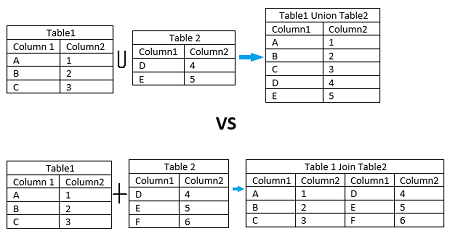📌 相关文章
- union 和 union all 有什么区别 - 不管(1)
- sql中的union vs union all(1)
- union 和 union all 有什么区别 - 不管代码示例
- sql代码示例中的union vs union all
- sql中的union all(1)
- MS SQL Server 中的 Union 和 Union All
- MS SQL Server 中的 Union 和 Union All(1)
- sql代码示例中的union all
- Oracle Union All
- Oracle Union All(1)
- sql中的union(1)
- SQLite Union All(1)
- SQLite Union All
- R 中 Dplyr 包中的 Union() 和 union_all() 函数
- R 中 Dplyr 包中的 Union() 和 union_all() 函数(1)
- Python中的 Union()函数(1)
- Python中的 Union()函数
- TypeScript Union(1)
- TypeScript Union
- sql代码示例中的union
- 在 Julia 中获取集合的并集 - union() 和 union!() 方法
- 在 Julia 中获取集合的并集 - union() 和 union!() 方法(1)
- Python中set的union
- Python Set union()
- Python中set的union(1)
- Python Set union()(1)
- UNION ALL 示例 postgres - SQL 代码示例
- MariaDB Union All运算符(1)
- MariaDB Union All运算符
📜 Union和Union All之间的区别
📅 最后修改于: 2020-11-19 02:03:15 🧑 作者: Mango
Union和Union All之间的区别
UNION和UNION ALL是数据库中用于合并多个表的结果集的两个最重要的SQL运算符。这些运算符使我们可以使用多个SELECT查询,检索所需的结果,然后将它们组合为最终输出。在本文中,我们将了解它们之间的区别。在进行比较之前,我们将简要讨论这些运算符。
什么是联盟运算符?
MySQL中的Union运算符允许我们将来自多个SELECT查询的两个或多个结果组合到单个结果集中。它具有默认功能,可从表中删除重复的行。此运算符语法始终使用第一个SELECT语句中的列名作为输出的列名。
MySQL Union必须遵循以下基本规则:
- 在所有查询中,列的数量和顺序应相同。
- 每个选择查询的相应列位置必须具有兼容的数据类型。
- 在不同的SELECT查询中选择的列名必须具有相同的顺序。
- 第一个SELECT查询的列名将是输出的列名。
注意:我们必须知道联合和联接是不同的。
- JOIN合并来自多个不同表的数据,而UNION合并来自多个相似表的数据。
- JOIN水平附加输出,而UNION垂直组合结果集。
下面的视觉表示更清楚地说明了这一点:

要阅读有关Union运算符的更多信息,请单击此处。
什么是Union All?
UNION ALL运算符组合来自多个SELECT查询的两个或多个结果,并将所有记录返回到单个结果集中。它不会从SELECT语句的输出中删除重复的行。
我们可以通过以下视觉表示理解它。

联合与联合所有运营商
下面的比较表快速解释了它们的主要区别:
| UNION | UNION ALL |
|---|---|
| It combines the result set from multiple tables and returns distinct records into a single result set. | It combines the result set from multiple tables and returns all records into a single result set. |
| Following is the basic syntax of UNION operator: SELECT column_list FROM table1 UNION SELECT column_list FROM table2; |
Following is the basic syntax of UNION ALL operator: SELECT column_list FROM table1 UNION ALL SELECT column_list FROM table2; |
| It has a default feature to eliminate the duplicate rows from the output. | It has no feature to eliminate the duplicate rows from the output. |
| Its performance is slow because it takes time to find and then remove duplicate records. | Its performance is fast because it does not eliminate the duplicate rows. |
| Most database users prefer to use this operator. | Most database users do not prefer to use this operator. |
联合和联合所有示例
让我们通过一个示例来了解Union和Union All运算符之间的区别。假设我们有一个名为“ Student”和“ Student2”的表,其中包含以下数据:
表:学生

表:Student2

以下SQL语句使用UNION查询从两个表中返回城市的唯一名称:
SELECT City FROM student
UNION
SELECT City FROM student2
ORDER BY City;
执行完上面的语句后,我们将得到以下输出,因为Union运算符仅返回不同的值。

以下SQL语句使用UNION ALL查询返回所有城市名称,包括两个表中的重复项:
SELECT City FROM student
UNION ALL
SELECT City FROM student2
ORDER BY City;
执行完上面的语句后,我们将得到以下输出,因为Union All运算符返回整个记录而不消除不同的值。
